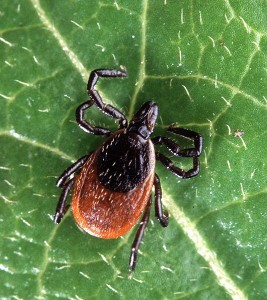CDC tests EU banned pesticide on US families’ yards
 UPDATE July 10, 2010: As of July 9, 2010, bifenthrin has been reapproved for use in the European Union.
UPDATE July 10, 2010: As of July 9, 2010, bifenthrin has been reapproved for use in the European Union.
The US Centers for Disease Control and Prevention has underwritten a human study on the use of pesticides to control Lyme disease. Hundreds of families in Maryland, Connecticut, and New York have been included in a blind study where some of the them have the pesticide bifenthrin sprayed around their homes and yards while the remaining homes are sprayed with water. The CDC wants to know if the spraying will reduce the number of cases of Lyme disease in humans. The CDC found their test subjects by mailing fliers to areas where Lyme disease was prevalent. The families who accepted the solicitation were told that there would be a one-time application of the pesticide. There have been several reports that the families in the testing program were not fully informed about the risks of the pesticide. Dr. Robert S. Lawrence, director of the Johns Hopkins University’s Center for a Livable Future, reviewed the solicitation and thought it should have been more clear about long-term safety and bifenthrin’s potential impact on humans. He also said that results from the first group tested found that, although there were fewer ticks in the treated properties, there were about the same number of cases of Lyme disease.
What is bifenthrin?
Bifenthrin, a pyrethroid insecticide, is used primarily against the fire ant but can be effective against many other insects, including ticks and mosquitos. The pesticide is used in orchards, nurseries, and homes, and in large amounts on corn. About 70% of all hops and raspberries in the US are treated with bifenthrin. Since bifenthrin is not very water soluble it often remains in the soil longer than any other pesticide. Although bifenthrin is effective against mosquitos it is thought that the insects will develop resistance which will soon limit its usefulness.
Is bifenthrin toxic?
Although bifenthrin is not very water soluble and will not rapidly cause ground water contamination, fish are very sensitive to the chemical because their slow metabolism keeps the poison in the system longer. Bees “will instantly die on small doses.” However, if the bees don’t die immediately, the entire colony could be affected by reducing fertility lessening the colony’s chance of survival. The pesticide is less immediately toxic to mammals, but, because of this fact and its biodegradability, its use is increasing, even being sprayed indoors, which could increase human exposure. Although the short term toxicity is not high in mammals, scientific tests have shown that bifenthrin can cause cell damage such as DNA breakdown and gene mutation. Since the chemical can accumulate in food, long-term effects from inflammation could “lead to autoimmune diseases like asthma, bronchitis, arthritis and cancer.” Human exposure to bifenthrin is through skin contact or ingestion. Excessive exposure can cause nausea, headaches, hypersensitivity to sound and touch, and skin and eye irritation.
Is bifenthrin regulated?
The US EPA has classified bifenthrin as a possible human carcinogen. It is a restricted use pesticide that can be legally sold in the US only by Certified Pesticide Applicators. Pesticides containing bifenthrin have recently been banned in the EU because of the carcinogenic effect.
How can human testing be justified?
If this pesticide is banned in the EU and is classified by the EPA as a possible carcinogen, it’s difficult to understand how it got approved for testing on humans, who probably include children who play in those treated yards. What does it take for a test to be disapproved? If the first year of the test did not show any reduction in cases of Lyme disease, how does the CDC justify deliberately exposing even more families to bifenthrin in the second round of tests? There is no argument that Lyme disease is harmful, but testing human subjects with a possible carcinogen goes too far, especially when early results show no reduction in incidence of the illness.
Sources:
The Baltimore Sun, Lyme disease tick study stirs dispute
Centers for Disease Control and Prevention, Lyme and Other Tickborne Diseases Prevention Studies (LTDPS), Yard Spraying Study
Wikipedia, Bifenthrin
Photo credit: Adult deer tick

The “EU ban” of bifenthrin is totally inaccurate. It just received Annex I inclusion this month (Jun 2012). The author has clearly not done their homework.
Thanks for your comment. Maybe banned by the EU is too strong a statement. Bifenthrin has apparently been “withdrawn from use in the European Union.” (Wikipedia) If that is not correct, please provide more information.
The Wikipedia reference is outdated (2009). The Councit did not include it in the Annex I inclusion in 2009, but new data was subsequently submitted to the EU by FMC to be reconsidered for registration. As of June, 2012, the Council has approved Annex I inclusion (registration). I would recommend reconsidering the assumption of an EU ban for your article. I believe a press release is being generated on the subject and I’ll link it when it comes out. Thanks
Thanks for the update. I’ll be looking for the news.
Anyone can call a pest control company and have it sprayed on their lawn already. Lots of people already do.